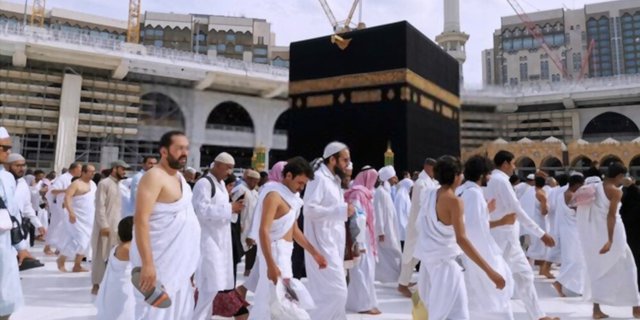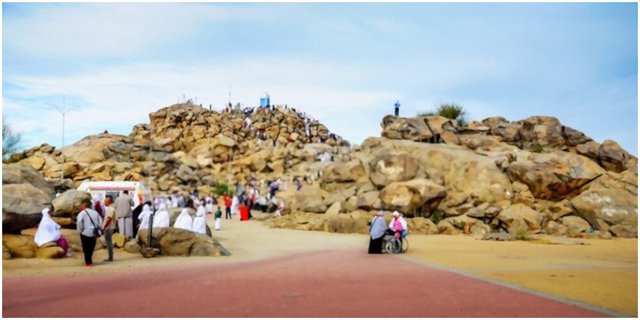Dream - In the month of Dzulhijjah, Muslims are met with a sacred worship moment that is only performed once a year, namely hajj worship. This fifth pillar of Islam is performed in the months of hajj, starting from the beginning of Shawwal until the Tarsyrik day in the month of Dzulhijjah.
It is obligatory for physically, mentally, and financially capable Muslims, so understanding the sequence of performing hajj worship is very important.
Hajj worship has pillars and obligations that are mutually continuous. Abandoning the pillars of hajj causes the hajj worship to be invalid, while abandoning the obligatory hajj can be replaced by paying a fine or compensation.
Before going to the Holy Land to perform hajj worship, Muslims need to understand the sequence of hajj that must be remembered from beginning to end. To make it clearer, read the following explanation about the sequence of hajj from beginning to end, summarized by Dream from various sources.
Hajj Sequence and How to Perform It
Although during the hajj worship there are people or guides who direct, but for prospective pilgrims it is necessary to know the sequence of hajj. Knowing the sequence of hajj and the correct procedures will make it easier for pilgrims to fulfill its requirements and pillars. Here is the sequence of hajj that must be remembered from beginning to end:
1. Performing Ihram
The first sequence of hajj is ihram, which is a mandatory pillar of hajj. Ihram is wearing all-white unsewn clothes for men and covering the entire body except the face and palms for women. In addition to wearing ihram clothes, pilgrims intend to perform ihram hajj.
Before ihram, pilgrims are advised to take a bath and ablution, trim nails, trim mustache, and trim armpit and pubic hair. The time to perform ihram starts from the month of Shawwal until the 9th of Dzulhijjah.
2. Standing at Arafah
The next sequence of hajj is standing at Arafah. The time for standing at Arafah starts from Dhuhr time on the 9th of Dzulhijjah until the 10th of Dzulhijjah. Pilgrims can stand at Arafah from noon until after Maghrib or nightfall until dawn. During this standing at Arafah, pilgrims are encouraged to pray and worship Allah SWT abundantly.
3. Tawaf Ifadah
Next, pilgrims head to the Kaaba to perform Tawaf Ifadah. The pilgrims circle the Kaaba seven times while reciting the talbiyah. Before performing Tawaf, they recite the intention first.
When reciting the talbiyah, men are advised to recite it loudly while women are advised to recite it softly. The Tawaf begins at midnight on the 10th of Dzulhijjah and can be performed on any day. It is more preferable to be performed on the days of Tashriq.
4. Sa'i
Sa'i is the next sequence of hajj after Tawaf. Sa'i is the act of walking briskly back and forth between the hills of Safa and Marwa seven times. The Sa'i journey ends at the hill of Marwa.
Sa'i starts with reciting the intention, then from the hill of Safa to the first green light by walking normally. Then from the first green light to the second green light, run briskly. Then proceed to the hill of Marwa by walking normally.
5. Staying at Muzdalifah
Staying or overnight at Muzdalifah starts from Maghrib time until dawn on the 10th of Dzulhijjah. Then it is allowed to leave Muzdalifah when the time for staying has passed midnight. During the stay at Muzdalifah, pilgrims collect 49 or 70 pebbles. These pebbles will be used for stoning the Jamrah.
Next Hajj Sequence...
6. Stoning the Jamrah Aqabah
The next sequence of hajj is stoning the Jamrah Aqabah seven times on the 10th of Dzulhijjah. It is not allowed to stone all seven at once, but to stone the pebbles one by one.
7. Shaving the Hair
After stoning the Jamrah Aqabah, it is followed by shaving the hair, at least three strands. It is also allowed for pilgrims who want to trim their hair.
8. Stoning 3 Jamrah
The next sequence of hajj is stoning the three Jamrah on the days of Tashriq, which are the 11th, 12th, and 13th of Dzulhijjah. There are three places for stoning the Jamrah, namely the first Jamrah near Haratullisan, the Wusto Jamrah located between the first Jamrah and the Jamrah Aqabah.
Meanwhile, the Jamrah Aqabah is located on the border of Mina and Mecca. The process of throwing pebbles at the three Jamrah must be done in order. Because if it is not in order, it is obligatory to start over. If the pilgrim is sick, then the stoning of the Jamrah can be delegated with the condition that it is still within the days of Tashriq.
9. Staying in Mina
Staying in Mina is done on the nights of the 11th, 12th, and 13th of Dhu al-Hijjah. If the stoning of the three pillars has been performed, then the Hajj pilgrims are allowed to leave Mina. Leaving (Mina) is divided into two, namely nafar awal and tsani.
Nafar awal means staying for two nights in Mina. Meanwhile, nafar tsani means staying for three nights. The Prophet Muhammad (peace be upon him) used to perform nafar tsani, which is staying for three nights.
10. Farewell Tawaf
The next step of Hajj is the farewell tawaf, also known as tawaf wada. This tawaf is performed when the pilgrims are about to leave the city of Mecca.
After the farewell tawaf, the pilgrims are not allowed to stay in hotels anymore, except only to wait for the bus or retrieve their belongings. Those who are sick or menstruating are not obliged to perform the farewell tawaf and are not subject to any penalty.
11. Tahalul
After all the hajj rituals have been performed, the last step is tahalul, which means a pilgrim is freed from ihram. Hajj tahalul is divided into two, namely the first and second tahalul.
The first tahalul indicates that the pilgrim has performed three types of hajj rituals, namely first, stoning the Jamrah Aqabah and shaving the hair. Second, when the pilgrim has performed the Tawaf Ifadah, Sa'i, and shaving the hair. Third, Tawaf Ifadah, Sa'i, and stoning the Jamrah Aqabah.
The second tahalul is performed when the pilgrim has completed three hajj rituals, namely stoning the Jamrah Aqabah, shaving the hair, Tawaf Ifadah, and Sa'i.
The Importance of Straightening the Intention for Hajj Worship
In performing hajj worship, it must be based on a sincere and correct intention. Namely making Allah SWT the only purpose in performing hajj worship and setting aside other goals that can affect sincerity and sincerity.
This is in accordance with His words in Surah Al-Baqarah verse 196:
وَاَتِمُّوا الْحَجَّ وَالْعُمْرَةَ لِلّٰهِ ۗ
Meaning: "And complete the hajj and umrah for Allah." (QS.Al-Baqarah: 196)
Based on the above verse, according to Syekh Nawawi Banten, the verse explains the obligation to complete all the pillars and requirements of hajj and umrah. All of them must be done sincerely and purely for worshiping Allah SWT without any other goals.
By straightening the good intention for performing hajj worship, God willing, it will become a hajj that is accepted, receive abundant rewards, and fulfill the fifth pillar of Islam perfectly.
That is the explanation of the sequence of hajj that must be remembered by prospective pilgrims. By knowing the above sequence of hajj, at least Dream's friends already understand the procedures for performing hajj worship before undergoing hajj rituals.
Sources: hayatuntour.com, NU Online, various sources.
Disclaimer: This translation from Bahasa Indonesia to English has been generated by Artificial Intelligence.











